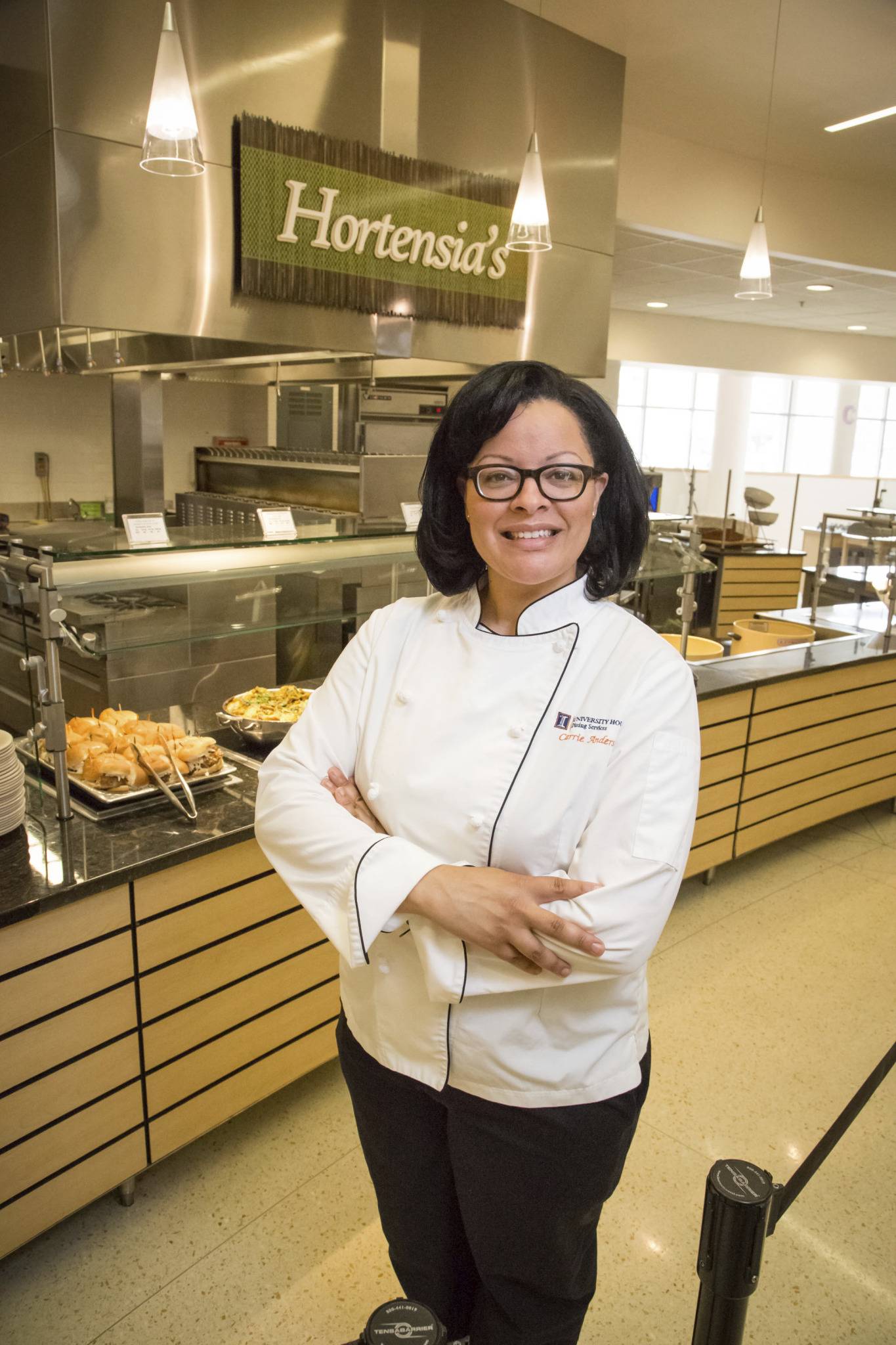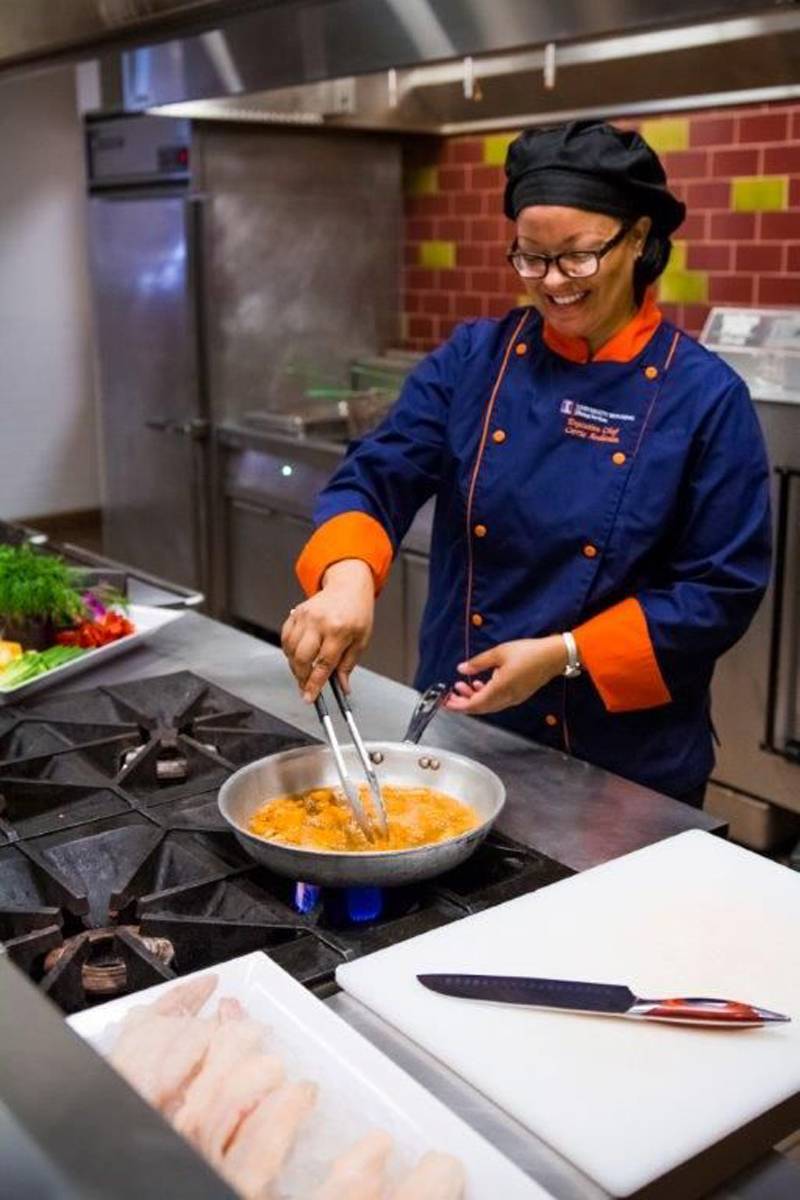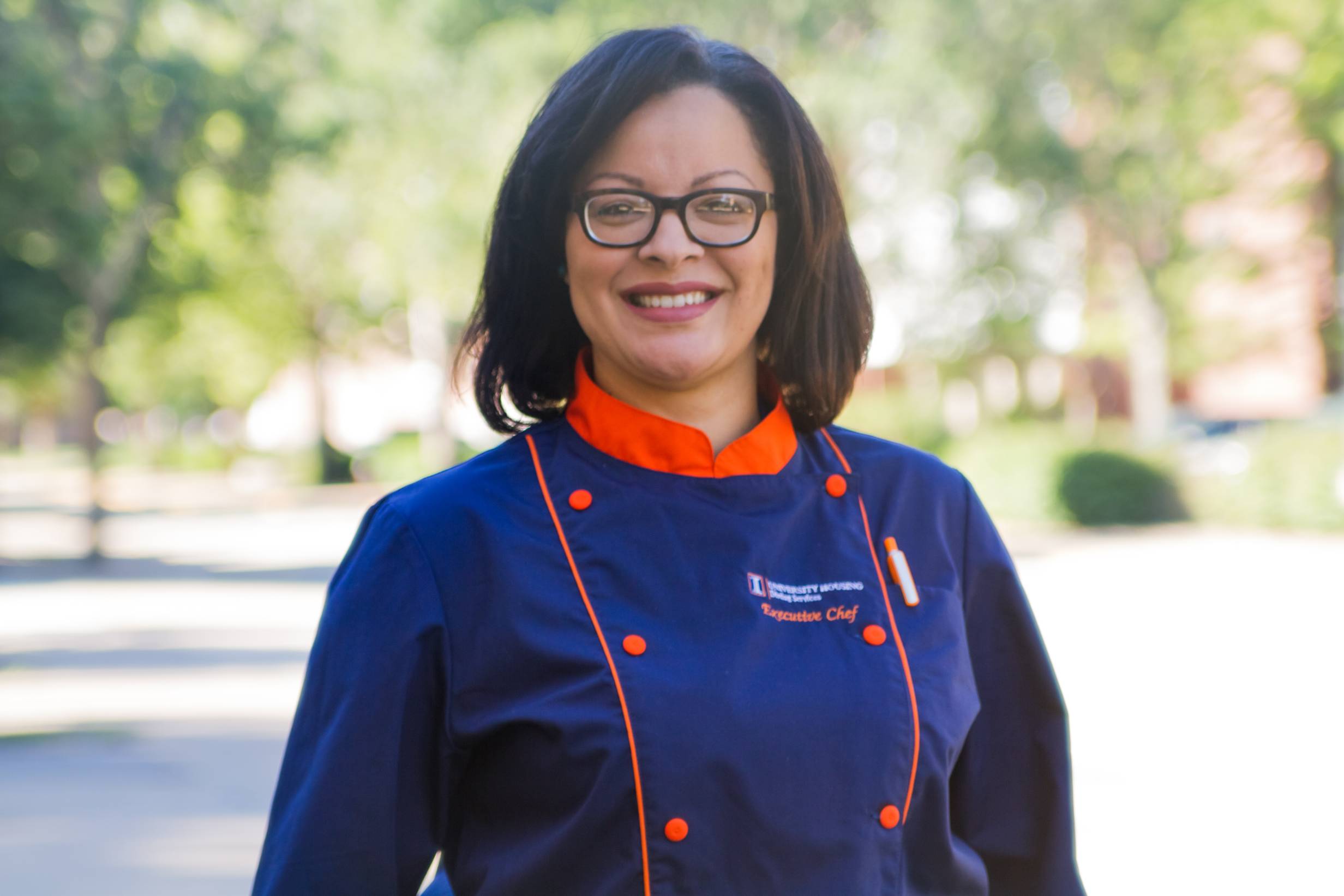Carrie Anderson is the Executive Chef for Residential Dining at the University of Illinois at Urbana-Champaign. I was interested in interviewing her because as a student who has stayed in university housing and eaten in the dining halls, I realize that we only get a very small perspective of everything that goes into feeding thousands of people each day. I was curious to know more about the behind-the-scenes of the housing dining at UIUC.
Anderson is enthusiastic about developing new recipes and collaborating with other chefs. She cares very much about the food being served in the dining halls. In our interview, she offers some insight into the logistics of food services for the U of I. Unforeseen obstacles, nutrition, and sustainability are some important considerations when planning meals for such large numbers of people.
Smile Politely: Tell us a little about yourself. How did you become a chef, and how did you end up at the U of I?
Carrie Anderson: I am a proud mother of 4, and active social justice advocate both at the University of Illinois, and in the local community. I became a chef because of my love for my mother’s food. After having my first child, and while pregnant with the second I began culinary school. My family and I landed here because it was a perfect fit for us at that time.

SP: What are the biggest challenges when planning for food service across so many dining establishments?
Anderson: Challenges can range from procurement of product, weather related phenomenon that affect crops or livestock, trends and fads, or varying customer preferences, just to name a few. The fact that there are a variety of changing variables at play all of the time I would say is a big challenge. Fortunately, there are always solutions to be found. I work with a great group of chefs and culinary professionals and together we problem solve, have ideation sessions, and recipe test to find solutions to these challenges.
SP: What are the biggest rewards?
Anderson: Developing and maintaining partnerships with colleagues and students here at Illinois and globally as these partnerships directly impact my ability to properly serve our customers. Seeing the excitement or appreciation on someone’s face when they love a dish. Seeing our culinary staff succeed and grow.
SP: How do you think about sustainability in sourcing food and as it relates to food waste?
Anderson: We think about sustainability constantly in Housing Dining. From the food we source, to what we do with food scraps and used items like gloves, glass, and aluminum. We want to be responsible stewards of our resources, because we have been entrusted with these resources to ensure that students have the fuel they need to be successful in meeting their educational goals. We source foods and materials from local vendors as often as possible. One example, and a personal favorite of mine, is Autumn Berry Jam. This delicious product is made from an invasive plant that grows in C-U, is harvested, and then turned into an incredibly tasty product.
From a pre-consumer standpoint, we try to generate very little waste. Some examples of ways in which we do that are using pineapple cores to make flavored water, or leaving the bottom on zucchini or yellow squash, and only removing the hard stem on top. These seem like very small things from the perspective of one or two pineapple or squash, but when you are prepping upwards of 20 cases (120 pineapples) of pineapple, or several hundred pounds of squash a day across Housing Dining, that adds up very quickly. We are using a new system called Grind to Energy at Florida Avenue Residence Hall, where both pre-consumer and post-consumer waste are turned into usable energy.
Here is a video about how it works:
SP: What sort of educational programs does Housing Dining offer across campus?
Anderson: Housing Dining partners with many colleges on campus. We have members of our team that guest lecture, and students that complete some of their hours of experiential learning in our kitchens. We conduct cooking classes across campus regularly that have both a culinary and educational component.
SP: What do you think is important for students to know about what you guys do?
Anderson: We cook from scratch, we have chefs in every dining hall, we care about each students’ experience when they dine with us, and we value our customers’ voices and opinions.
SP: How does Housing Dining promote health through the dining hall?
Anderson: Housing Dining promotes health in many ways! We have two registered dieticians on staff, one that works directly with the culinary team, and one that works directly with students. Through their expertise, we educate ourselves and our customers about making healthy choices. We have both the Illinois App, and eatsmart.housing.illinois.edu that customers can access to help select food items that meet their specific dietary needs. We display nutrition information next to the foods we serve, we serve local and seasonal whenever possible, and we provide a wide variety of options.
SP: How do you decide the menus for each location?
Anderson: We determine menu guidelines yearly that help set the foundation for menu construction. Then, our culinary team meets regularly to access customer satisfaction with menu items. This is an ever-evolving process.
SP: With such a diverse campus community, how does Housing Dining incorporate tastes of home or celebrate holidays through the menus?
Anderson: Housing Dining takes an immense amount of pride in celebrating the diversity of our Illinois student population through the culinary arts. Through customer participation, collaborations with the cultural houses, various RSOs and LLCs, Chabad Center for Jewish Life, and restaurants in the local community, we strive to create experiences that help to celebrate important observations, holidays, or just flavors from home that are important to our students. These times also serve as immersive educational opportunities for those that visit our dining spaces. When possible, we incorporate music, dance, art, and literature to help round out that immersive experience.

SP: What is your favorite dish that is served?
Anderson: I have so many! I love mapo tofu, a dish we learned to make from a group of Illinois international students through a collaborative program we host during Fall Break. I love Soul Food Thursdays at Florida Avenue Residence Hall because it reminds me of the foods I fell in love with during my childhood. I love when we grill hot dogs from the Meat Science Department on campus at outdoor events, as they are literally the best hot dogs I have ever tasted! I love the bacon caramel biscuits that Chef Eric Larson makes at the SDRP! I love our mac and cheese, our fresh vegetables from the Student Sustainable Farm, and I love every time one of our culinary team says, “Hey, Chef Carrie come taste this!”. I can immediately tell from their expression how proud they are, and it makes that bite taste even better.
SP: What’s a food trend that you think is overrated?
Anderson: Charcoal anything!
SP: Anything else you’d like to share with readers?
Anderson: I would like your readers to know that Housing Dining has a team of culinary professionals that truly value our customers patronage, feedback, and satisfaction. We want all who enter our dining space to feel welcomed and celebrated.
Photos courtesy of Carrie Anderson and the University of Illinois Housing Marketing Department








